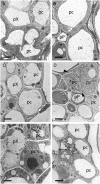Diarch symmetry of the vascular bundle in Arabidopsis root encompasses the pericycle and is reflected in distich lateral root initiation
- PMID: 17993548
- PMCID: PMC2230548
- DOI: 10.1104/pp.107.107870
Diarch symmetry of the vascular bundle in Arabidopsis root encompasses the pericycle and is reflected in distich lateral root initiation
Abstract
The outer tissues of dicotyledonous plant roots (i.e. epidermis, cortex, and endodermis) are clearly organized in distinct concentric layers in contrast to the diarch to polyarch vascular tissues of the central stele. Up to now, the outermost layer of the stele, the pericycle, has always been regarded, in accordance with the outer tissue layers, as one uniform concentric layer. However, considering its lateral root-forming competence, the pericycle is composed of two different cell types, with one subset of cells being associated with the xylem, showing strong competence to initiate cell division, whereas another group of cells, associated with the phloem, appears to remain quiescent. Here, we established, using detailed microscopy and specific Arabidopsis thaliana reporter lines, the existence of two distinct pericycle cell types. Analysis of two enhancer trap reporter lines further suggests that the specification between these two subsets takes place early during development, in relation with the determination of the vascular tissues. A genetic screen resulted in the isolation of mutants perturbed in pericycle differentiation. Detailed phenotypical analyses of two of these mutants, combined with observations made in known vascular mutants, revealed an intimate correlation between vascular organization, pericycle fate, and lateral root initiation potency, and illustrated the independence of pericycle differentiation and lateral root initiation from protoxylem differentiation. Taken together, our data show that the pericycle is a heterogeneous cell layer with two groups of cells set up in the root meristem by the same genetic pathway controlling the diarch organization of the vasculature.
Figures







Similar articles
-
The D-type cyclin CYCD4;1 modulates lateral root density in Arabidopsis by affecting the basal meristem region.Proc Natl Acad Sci U S A. 2009 Dec 29;106(52):22528-33. doi: 10.1073/pnas.0906354106. Epub 2009 Dec 15. Proc Natl Acad Sci U S A. 2009. PMID: 20018777 Free PMC article.
-
Phloem-associated auxin response maxima determine radial positioning of lateral roots in maize.Philos Trans R Soc Lond B Biol Sci. 2012 Jun 5;367(1595):1525-33. doi: 10.1098/rstb.2011.0239. Philos Trans R Soc Lond B Biol Sci. 2012. PMID: 22527395 Free PMC article.
-
Mutations in the Diageotropica (Dgt) gene uncouple patterned cell division during lateral root initiation from proliferative cell division in the pericycle.Plant J. 2006 May;46(3):436-47. doi: 10.1111/j.1365-313X.2006.02702.x. Plant J. 2006. PMID: 16623904
-
Surfing along the root ground tissue gene network.Dev Biol. 2012 May 1;365(1):14-22. doi: 10.1016/j.ydbio.2012.02.007. Epub 2012 Feb 12. Dev Biol. 2012. PMID: 22349629 Review.
-
Lateral root initiation or the birth of a new meristem.Plant Mol Biol. 2006 Apr;60(6):871-87. doi: 10.1007/s11103-005-4547-2. Plant Mol Biol. 2006. PMID: 16724258 Review.
Cited by
-
Two types of bHLH transcription factor determine the competence of the pericycle for lateral root initiation.Nat Plants. 2021 May;7(5):633-643. doi: 10.1038/s41477-021-00919-9. Epub 2021 May 18. Nat Plants. 2021. PMID: 34007039
-
Interplay of Auxin and Cytokinin in Lateral Root Development.Int J Mol Sci. 2019 Jan 23;20(3):486. doi: 10.3390/ijms20030486. Int J Mol Sci. 2019. PMID: 30678102 Free PMC article. Review.
-
At-Hook Motif Nuclear Localised Protein 18 as a Novel Modulator of Root System Architecture.Int J Mol Sci. 2020 Mar 10;21(5):1886. doi: 10.3390/ijms21051886. Int J Mol Sci. 2020. PMID: 32164240 Free PMC article.
-
Characterization of TCTP, the translationally controlled tumor protein, from Arabidopsis thaliana.Plant Cell. 2008 Dec;20(12):3430-47. doi: 10.1105/tpc.108.061010. Epub 2008 Dec 5. Plant Cell. 2008. PMID: 19060111 Free PMC article.
-
Genome-wide direct target analysis reveals a role for SHORT-ROOT in root vascular patterning through cytokinin homeostasis.Plant Physiol. 2011 Nov;157(3):1221-31. doi: 10.1104/pp.111.183178. Epub 2011 Sep 27. Plant Physiol. 2011. PMID: 21951467 Free PMC article.
References
-
- Barlow P (1984) Positional controls in root development. In PW Barlow, DJ Carr, eds, Positional Controls in Plant Development. Cambridge University Press, Cambridge, UK, pp 281–318
-
- Beeckman T, Burssens S, Inzé D (2001) The peri-cell-cycle in Arabidopsis. J Exp Bot 52 403–411 - PubMed
-
- Casero P, Casimiro I, Knox J (1998) Occurrence of cell surface arabinogalactan-protein and extensin epitopes in relation to pericycle and vascular tissue development in the root apex of four species. Planta 204 252–259
-
- Casero PJ, García-Sánchez C, Lloret PG, Navascués J (1989) Changes in cell length and mitotic index in vascular pattern-related pericycle cell types along the apical meristem and elongation zone of the onion root. Protoplasma 153 85–90
-
- Casimiro I, Beeckman T, Graham N, Bhalerao R, Zhang H, Casero P, Sandberg G, Bennett MJ (2003) Dissecting Arabidopsis lateral root development. Trends Plant Sci 8 165–171 - PubMed
Publication types
MeSH terms
Substances
LinkOut - more resources
Full Text Sources
Other Literature Sources

